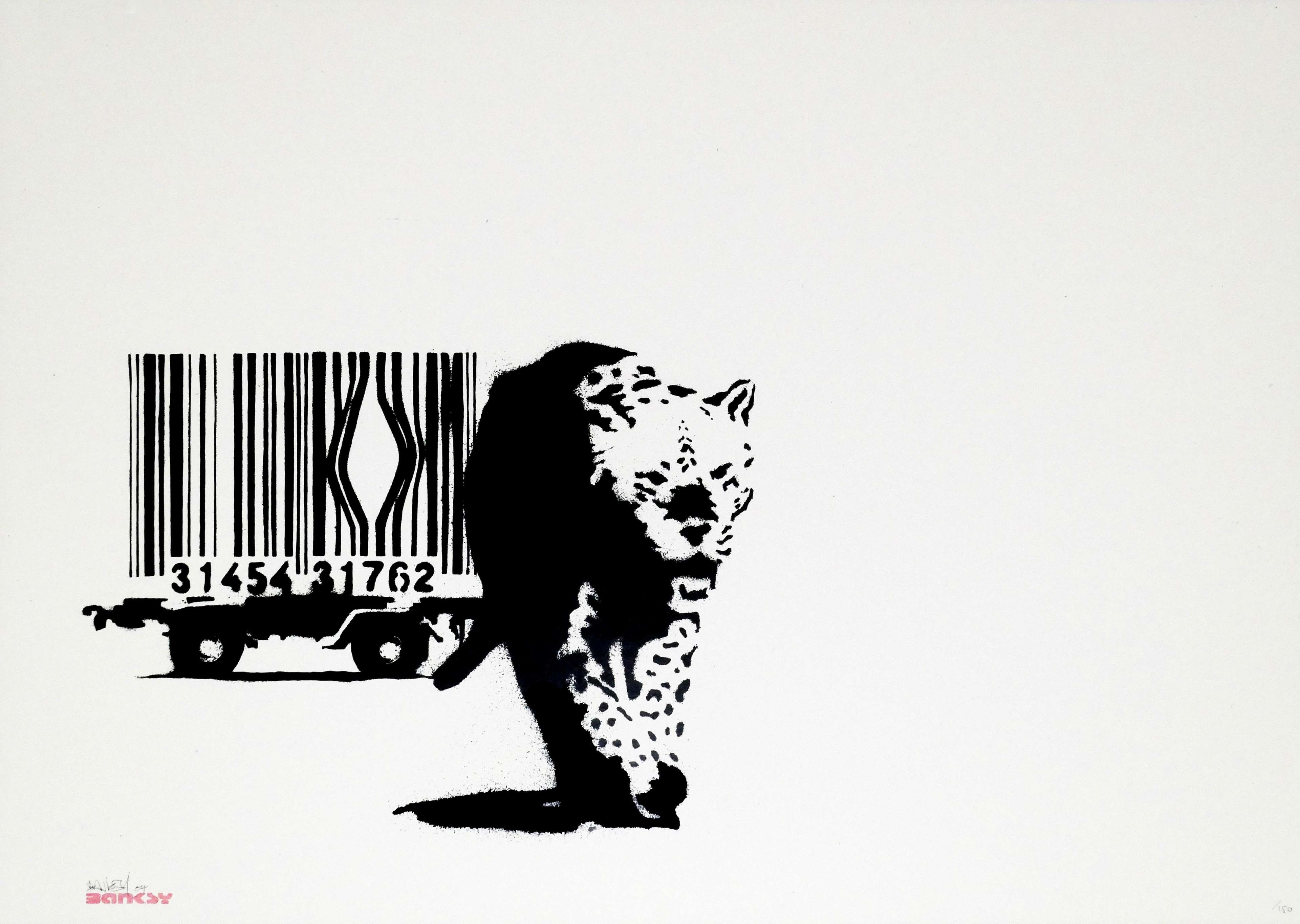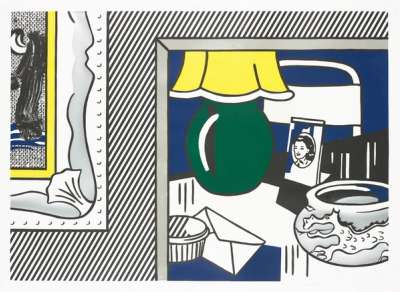 Morons © Banksy 2006
Morons © Banksy 2006Live TradingFloor
Art and auction terminology can be confusing, even for the experienced. From absentee bid to white glove sale, here is our glossary of the most common terms – in case you’ve always wanted to know, but were too afraid to ask.
A
What is an absentee bid?
Also known as a commission bid, an absentee bid is a method of auction bidding where a person, who may not attend the sale, can leave their bid in advance.
What is an appraisal? An appraisal is a formal evaluation of an item’s value at auction or insurance value. See also valuation. If you’re looking for an appraisal today, for any of the artists that we specialise in, you can submit one in seconds here.
What is an Artist’s Resale Right or Artist’s Resale Royalty (ARR)?
Also known as ‘Droit de Suite’, this right entitles living artists and artists who have died within the last 70 years a royalty every time their work is sold by an art market professional in the EU or UK, subject to certain conditions. It is the joint responsibility of the art market professional and the seller to ensure the resale royalty is paid.
B
What is a bid?
A bid is the price a prospective buyer signals they would like to pay during an auction. Bids can be placed in the auction room, via the phone, online or through absentee bids.
What is a Biennale?
The Italian word for “biennial” or “every two years”, Biennale commonly refers to international art fairs that take place every other year. The best known is the Venice Biennale
What does blue chip art mean?
Blue chip art is created by famous or widely recognised artists, and whose value is expected to increase or remain stable regardless of economic ups and downs. Blue chip artists include Pablo Picasso, Andy Warhol, Jean-Michel Basquiat and Jeff Koons. It is colloquially assumed that artists or artwork relating to the blue chip genre are works that are both culturally legitimate and of investment grade
What does “bought in” mean?
Also referred to as B.I., bought in traditionally meant a lot was unsold at auction and the auction house themselves bought it from the seller. Today, it is more commonly another term for passed.
What does “burned” mean?
An item that is unsold at public auction risks being “burned” or “burnt”, damaging its short-term value, reputation and desirability on the market. This is one of the reasons our clients opt to sell with us via a private sale.
What is buyer’s premium?
Buyer’s premium is a percentage of the hammer price, paid by the buyer to the auction house. VAT may be charged on top.
C
What is a catalogue raisonné?
A catalogue raisonné is a detailed and extensive catalogue listing all the known works by an artist (their oeuvre), often accompanied by annotations and analysis
What is a certificate of authenticity (COA)?
A COA is a document accompanying an artwork confirming it is authentic and genuine. A COA can be issued by the artist, their estate or their dedicated authentication body – such as Pest Control for Banksy. Some COAs are created at the same time as the artwork, others are issued retroactively.
What is a commission bid?
See absentee bid.
What is a condition report?
A condition report is a written description detailing the condition of an item. This may be helpful for prospective buyers who cannot view the work in person. All the works we offer from our network come with an in-depth conditional report pertaining to their original condition, any work carried out and an appraisal of any work needed by our specialist conservators. If you’d like to enquire about the condition of any of our works just get in touch.
What does consign mean?
Traditionally meaning “to send something to someone”, auction houses use the term “consign” to mean “sell at auction”. A “consignor” is a seller, a “consignee” is a buyer, and a “consignment” is the lot offered to auction, or for private sale via an intermediary like an auction house, private sale platform such as ours, or a gallery.
What does “contemporary” mean?
At auction, this hard-to-define category can indicate art made after 1945 to present day, or artists who are currently still alive, and is often offered alongside post-war art. Which artists are defined as “post-war” or “contemporary” is often at the discretion of the auction house.
 CoA @ Pest Control 2020
CoA @ Pest Control 2020D
What are the Three D’s?
Death, debt and divorce are still considered, rather pessimistically, to be the three biggest motivations for bringing items to auction. Downsizing and disaster may also be factors.
E
What is an edition?
An edition is a work of art made in a series – a limited edition has a set number of works (edition size), while an open edition has no set edition size.
What is an estimate?
An estimate is a price range that auction house experts believe an item will sell for, although some auction houses will purposely set a low estimate to encourage bidding. Other auction houses, such as Christie’s, charge an additional fee if an item sells above its estimate (see Performance Commission fee).
F
What does “fair warning” mean?
This is a warning given by the auctioneer to signal the final opportunity to bid, before they bring down the gavel. In extended bidding battles, an auctioneer may call “fair warning” several times.
What does “fresh to market” mean?
A fresh-to-market artwork is one that has never been offered at auction before.
G
What is a guarantee?
An auction house can guarantee to pay a seller for their lot, even if the lot does not reach the reserve price – this can be to incentivise the seller to sell by removing risk of their item being burned. A third-party guarantee is a guarantee provided jointly with, or independently of, an auction house.
H
What is a hammer price?
Hammer price is the price on which the auctioneer’s gavel (hammer) falls, but this price does not include buyer’s premium or VAT.
What is hilling?
Hilling is a Christie’s insider term for when the auction house’s specialists gather for detailed examination of an artwork before it is catalogued and priced.
L
What is a live auction?
A live auction takes place with an auctioneer taking bids in real time from multiple channels, whereas an online auction is managed entirely from one digital channel.
What is a lot?
A lot is an individual object, artwork, or a group of objects, offered for sale via auction as a single unit.
M
What does “modern” mean?
At auction, the modern art category indicates art made from the late 19th-century until the end of World War II (1945). These works are often offered alongside post-war and contemporary art, or as a separate category, at the discretion of the auction house.
What is a multiple?
A multiple is a limited-edition 3D artwork, such as a KAWS toy or a ceramic by Picasso. The term edition is used for 2D works within a series.
O
What does “oeuvre” mean?
Oeuvre means the complete works of a painter, musician or writer.
What is overhead premium?
Sotheby’s Overhead Premium is a fee of 1% of the hammer price, plus any applicable local taxes, to cover their overhead costs for facilities, property handling and admin expenses.
P
What does “pass” mean?
A pass means bidding did not reach the minimum price set by the seller, so the lot is unsold and remains the property of the owner. Some auction houses charge a fee to the seller even if the item does not sell. See also bought in.
What is a performance commission fee?
Christie’s Performance Commission fee is a 2% charge of the hammer price, paid by the seller to the auction house, in the event the item sells for over the high estimate. This is on top of the seller’s commission.
What does “post-war” art mean?
At auction, the post-war category indicates art made after 1945 and is often offered alongside contemporary art. Which artists are defined as “post-war” or “contemporary” is often at the discretion of the auction house.
What is primary market?
Primary market is when an object is sold for the first time, usually directly from the artist, artist’s studio or their represented gallery. See also secondary market.
What is a private sale?
Unlike public auctions, private sales take place discreetly between buyers and sellers, usually negotiated by a dealer, auction house or a broker, such as MyArtBroker.
What is provenance?
Provenance is the record of previous ownership of an object, which can include its certificate of authenticity, sale documents, exhibition paperwork and conservation or restoration history, all of which serves as proof of its authenticity. Often referred to as the artworks papertrail.
R
What is a reserve price?
A reserve, or reserve price, is a confidential minimum price agreed between the seller and the auction house – if bidding does not meet the reserve price, the item will not be sold.
What is restitution?
Restitution is the process of returning stolen items or artworks to their rightful owners.
What is a retrospective?
A retrospective is an exhibition that surveys a period, or the entire course, of an artist’s career.
S
What is secondary market?
A secondary market deals with artworks that have already been sold at least once before. See also primary market.
What is seller’s commission?
Also known as seller’s premium, this is a percentage of the hammer price, paid by the seller to the auction house. At MyArtBroker, we charge 0% seller’s commission, meaning it is free to sell. We only charge buyers a market leading low commission to buy.
U
What is an underbidder?
An underbidder is the person who offered the second-highest price at auction, just below the winning bid.
V
What is a valuation?
A valuation contains a detailed description and current value of an item, which can be used for insurance, estate taxes, estate planning, charitable contribution and other needs. See also appraisal. You can request a valuation for your artwork via MyArtBroker here.
What is a vendor?
Another term for seller or consignor.
What is a viewing?
A viewing is an exhibition held by an auction house to invite prospective buyers, and sometimes the public, to browse the items coming up for sale.
What is vetting?
At art fairs, vetting is a process where a team of external experts check the items before the sale to ensure they are genuine and uphold the quality of the fair. It can also refer to the process of ensuring something is authentic, or condition checked by a specialist.
W
What is a white glove sale?
A white glove sale is an auction where 100% of the lots are sold.
What is a withdrawn lot?
A withdrawn lot is a lot that has been removed after the release of the catalogue or sale, but prior to an auction actually taking place. Auction houses may charge a withdrawal fee to the seller if the lot was removed at their request. Other reasons for lots being removed, can be because the work was deemed unauthentic at closer inspection or they have reasons to suspect the consignor does not own the work once consignment process is complete.

















































